Famous Irish Traditions: Music, Sports, Folklore & More
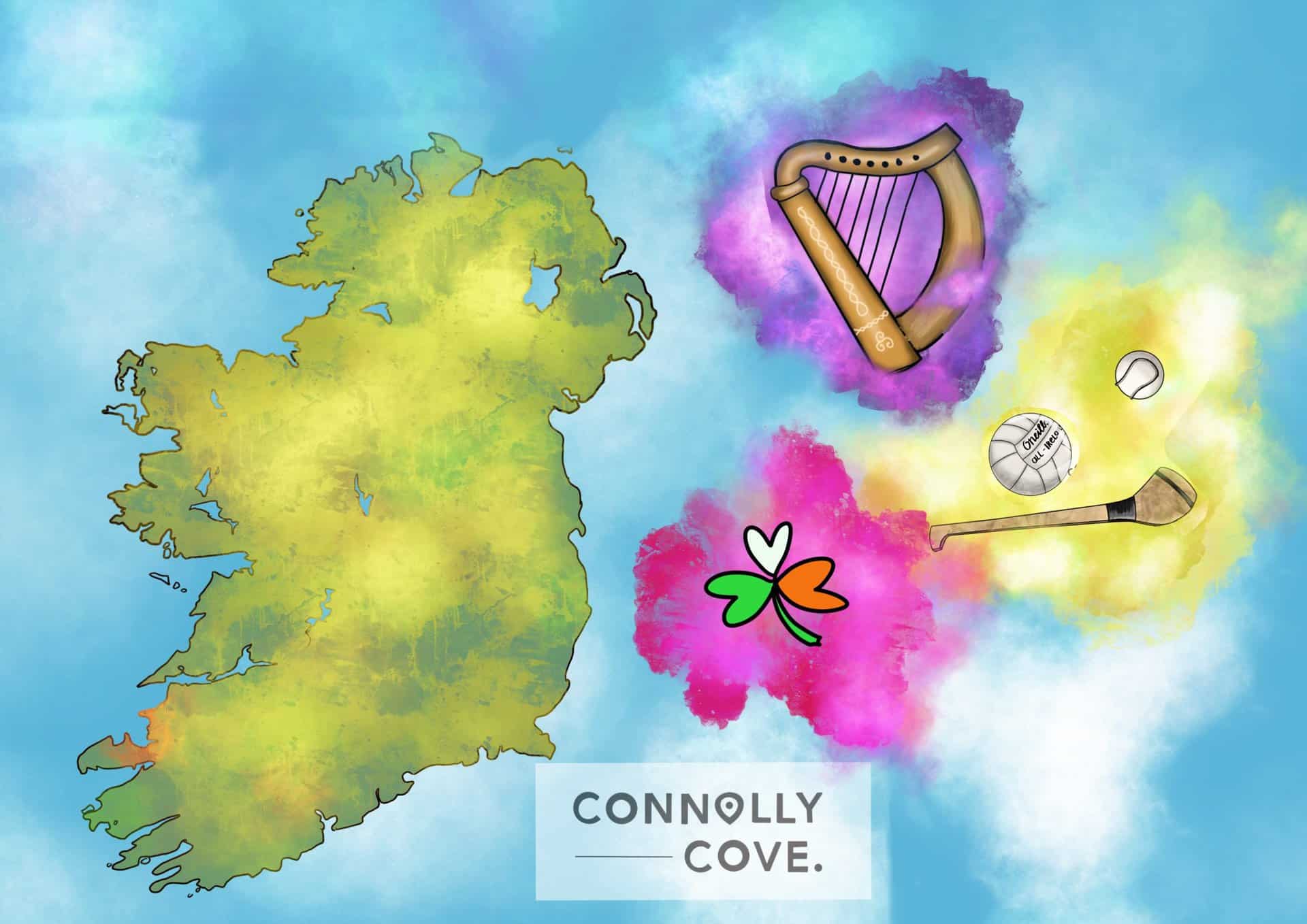
Updated On: April 23, 2024 by Yomna Salah
Ireland is a country that has always done things differently. We have our own Irish culture and traditions that distinguish us from anywhere else in the world. Our language, music, arts, literature, folklore, cuisine, and sports are all special and unique to the Irish people. Below is a comprehensive guide to some fascinating Irish traditions, culture, and celebrations.
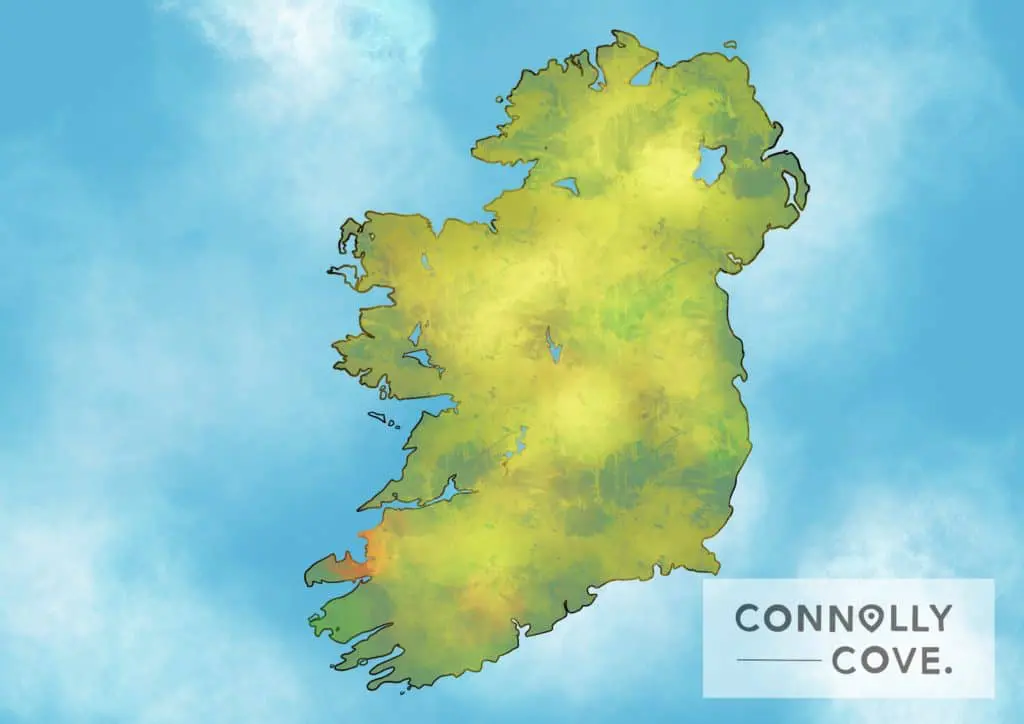
Influence of Irish Traditions
Angelo-Norman, Scottish & English Culture have influenced much Irish tradition. But of course, the most significant influence on Irish traditions and customs has been Gaelic and Celtic culture. In the 12th century, the Anglo-Normans invaded Ireland. Then, further into the 16th and 17th centuries, the Anglo-Irish and Scot-Irish (Ulster Scots) arrived in Ireland.
In modern times, many traditions differ between various communities in Ireland. Christian denominations such as Catholics and Protestants each have their customs and traditions. Irish traditions also differ between ethnic groups. For example, the travelling community has versions of Irish customs and traditions.
Although many traditions are only present in Ireland, some aspects of the culture of Ireland are shared with other countries. This includes Britain, some English-speaking or catholic European countries and Celtic nations.
Because many Irish people have emigrated to different parts of the world throughout history, Irish traditions and culture have reached a global audience. Traditional Irish festivals and celebrations such as St. Patrick’s Day and Halloween have spread far beyond Ireland and are celebrated around the globe.
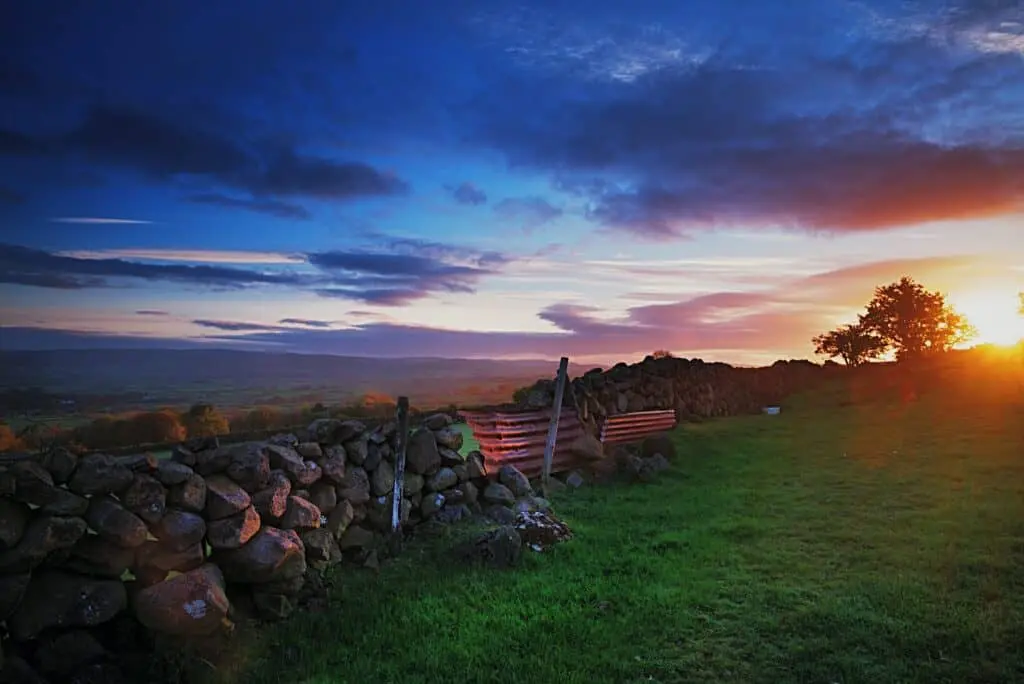
Join us as we explore some of the most exciting and uniquely Irish Traditions. The list below breaks down the customs, traditions, and celebrations we will cover in this article. Please scroll down to read them all, or click a heading to jump to that section!
Table of Contents
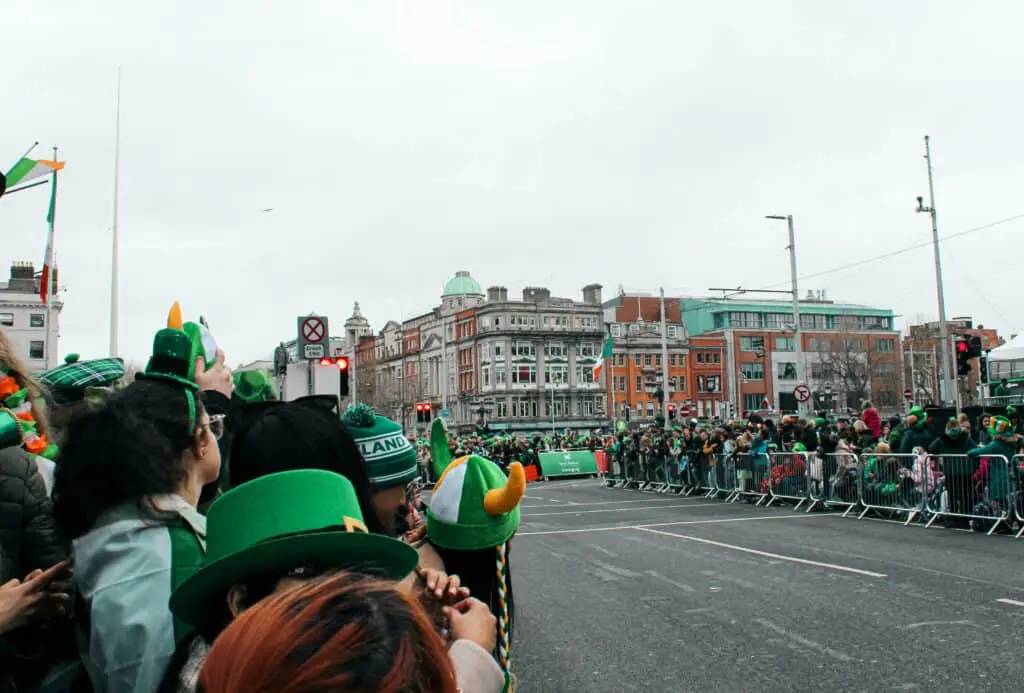
Traditional Irish Festivals & Celebrations
Saint Patrick’s Day
One of the most famous and iconic Irish traditions is the feast of Ireland’s Patron Saint, St. Patrick. He is one of the best-known figures to ever come from Ireland. 17 March is known and celebrated as St. Patrick’s Day worldwide.
A detail that not everyone knows is that St. Patrick wasn’t Irish. He was born and raised in Roman-occupied Britain. When he was 16 years old, he was kidnapped by Irish pirates and forced into slavery in Ireland.
During his time as a slave, Patrick turned to God, praying often as his faith began to grow. Six years later, he got a ‘calling from God’ telling him to head to a port over a hundred miles away. He followed this calling and left Ireland, returning home to Wales.
However, this was not the end of St. Patrick’s time in Ireland. While he was home, he had a vision which convinced him to bring Christianity to the Irish people. St. Patrick returned to fulfil this vision, and from that moment on, he became an iconic figure associated with Ireland.
Patrick passed away on 17 March, 461 AD, after a lifetime of preaching the word of Christ. The People of Ireland began to celebrate this day in remembrance of him. Subsequently, during the 19th century, when the Irish immigrated to America and other parts of the world, the celebration of St. Patrick was brought with them.
From that moment onwards, the patron Saint of Ireland became a global celebration and a symbol of Irish culture. Irish traditions associated with Saint Patrick’s Day include wearing the colour green, wearing a Shamrock and enjoying a day full of festivals and parades.
St. Patrick’s Day, Paddy’s Day, or St. Patty’s Day, sometimes referred to in the USA, is known as the day “where everyone is a little Irish”. It shows how widespread – and welcoming – Irish culture is; people are eager to join in and celebrate!
Traditional Irish celebrations of St. Patrick’s Day include parades in each town. The parades are filled with conventional musical and dance acts, showcasing the community’s pride. Public figures are in attendance, and parade floats often depict relevant parodies or issues of the previous year.
St. Patrick’s Day is not the only day the Irish people honour the Patron Saint. On the last Sunday of July, it is common for people in Ireland to pilgrimage to Croagh Patrick in Co. Mayo. People climb to the mountain’s summit – sometimes barefoot- and go to mass inside the church at the top.
Croagh Patrick, or the “reek” as it is commonly known, was named after the Saint as he spent 40 days and 40 nights fasting on top of the mountain while he was kept as a slave.
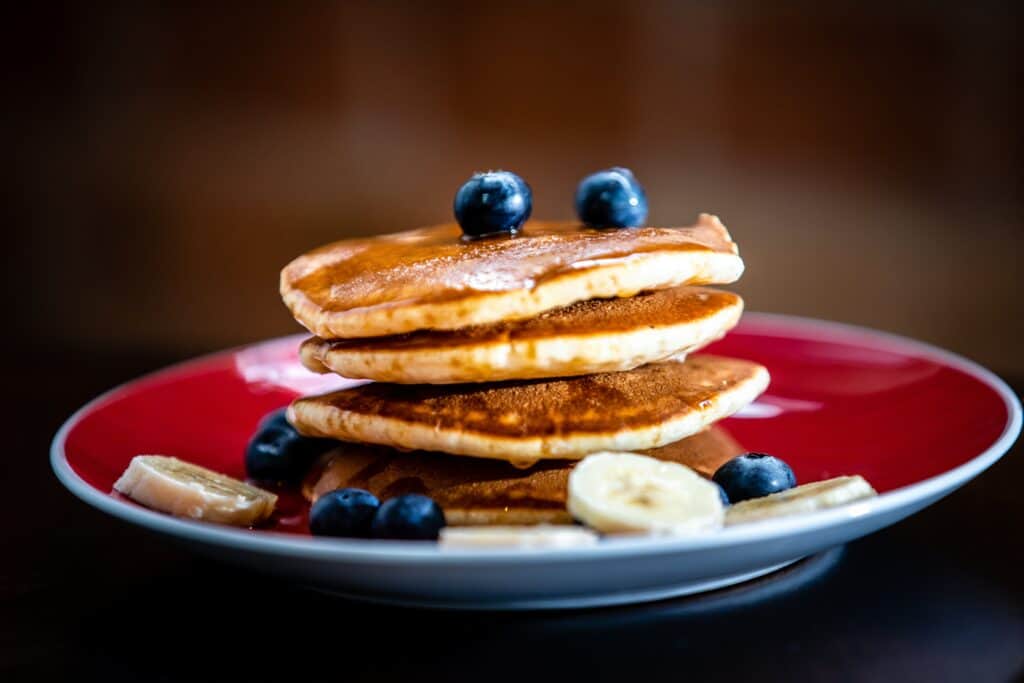
Shrove Tuesday or Pancake Tuesday
In the past, most Irish people practised Roman Catholicism, and Shrove Tuesday marked the beginning of Lent. Lent is 40 days and 40 nights that Jesus fasted in the desert before the celebrations of Easter take place.
Families would feast on Shrove Tuesday, using all the ingredients that would not keep fresh over the following 40 days, such as eggs, sugar, milk, salt, flour and butter.
Pancakes became popular as they contained all of the ingredients that would spoil. Additionally, they could be altered easily to accommodate extra or missing ingredients and were quick to make.
Nowadays, most Irish people do not fast during Lent, but they may give up one particular item. Nonetheless, pancake Tuesday is trendy and is often celebrated in schools and at home, marking the beginning of the countdown to Easter.
Halloween Traditions
For those that don’t know, the famous festival of Halloween originates from the Celtic Pagan festival called ‘Samhain” (Ending of Summer) that took place in Ancient Celtic Ireland.
Over a thousand years ago, Irish Ancestors celebrated the beginning of winter with the Festival of Samhain on 31 October. They believed this was the best time to open the link between our world and the spirit world, allowing the dead to return to Ireland on this night.
Many of our current Irish Halloween traditions, such as dressing up and carving pumpkins into jack-o’-lanterns, come from this Irish Celtic festival. During the celebration of Samhain, people would disguise themselves with animals to protect themselves from evil spirits. They would carve out scary faces on turnips and leave them at their doors to ward off evil spirits.
The Irish would also light fires to guide good spirits during Samhain. One of Ireland’s most popular modern Halloween customs includes children disguised in costumes and going from door to door trick-or-treating.
Many of these Irish traditions can still be seen in today’s celebration of Halloween. As Irish people emigrated to America, they brought Halloween festivities with them. Some traditions were altered over time, however. For example, turnips were hard to find in America, so people began carving out pumpkins instead.
As more and more countries began celebrating Halloween, it became a huge festival with parades and events happening all around the globe. So, next time you yell “Trick or treat!” in exchange for sweets, you can thank the ancient Irish and Celts!
St. Brigid’s Day
St. Patrick is not the only Patron saint of Ireland who is celebrated. St. Colmcille is another saint whose feast day is on 9 June. Similarly, St. Brigid of Kildare also has her fair share of Irish folklore and unique celebrations.
1 February marks St. Brigid’s day. This Irish traditional holiday is celebrated on the same day that the Celtic Pagan festival of Imbolc was held. Imbolc celebrated the Pagan Goddess Brigit and marked the halfway point between Winter and the Spring Equinox.
On St. Brigid’s Day, it is customary in Ireland to make a cross out of rushes and bring it to mass to get blessed. The cross is then placed over the entrance of the home to help keep everyone in the house healthy.
Each cross is kept for an entire year. When a new cross is created and blessed, the previous year’s cross is moved out into a shed or farmhouse to bless the farm. Irish home traditions like this are still seen in many houses today.
St. Brigid performed many miracles. The most famous was when she used her magical cloak, which allowed her to build a monastery in Kildare. The legend goes that when Saint Brigid’s request to make a monastery in a field was denied, she asked for as much land as her small cloak would cover.
The King was bemused by this and allowed her to throw her cloak on the field she wanted. Brigid and her sisters prayed to God for a miracle, and when Brigid threw her cloak, it began to expand in every direction. The King who had witnessed this realised that Brigid was truly blessed and converted to Christianity, assisting Brigid in her mission to build the monastery.
St. Brigid shares similarities to the ancient Celtic Goddess Brigit of the mythological tribe Tuatha de Danann. Brigit was the Celtic Goddess of Fire and Light, known for her generosity. She was part of the Tuatha de Danann, a race of supernatural deities. In Irish mythology, the Saint and the goddess are the same person; the Goddess was turned into a Saint when Christianity took over Ireland.
Christmas Irish Traditions
In Ireland, Christmas is a significant celebration. Christmas in Ireland is usually celebrated from Christmas Eve (24th of December) until the Feast of Epiphany (6 January). This holiday comes with many Irish traditions. Irish People have their unique customs when it comes to celebrating Christmas.
There is an old tradition in Irish homes at Christmas: a tall, thick candle would be placed on window sills after sunset on Christmas Eve. The candle would burn all night as a welcoming symbol for Mary and Joseph. There are still people in Ireland who practice this tradition.
In the Irish language, Christmas is called ‘Nollaig’, and Santa Claus is called ‘San Nioclás’. Like most places, Irish children go to sleep on Christmas Eve and hope to wake up in the morning with presents left from Father Christmas.
Across homes in Ireland, food is left out for Santa Claus on the night of Christmas Eve. These snacks range from milk and cookies to Guinness and mince pies. Some households even leave out a glass of whiskey to warm him up for the long journey ahead!
Traditionally, the people of Ireland attended mass on Christmas Eve. To this day, midnight mass is a popular way to celebrate Christmas day with family and friends.
More Irish Christmas Traditions
In Ireland, the day after Christmas is called St. Stephen’s Day. It is also known as Boxing Day in parts of the UK. This holiday is dedicated to Saint Stephen, the first Christian Martyr. However, the traditional Irish celebrations have very little to do with him.
Historically, it was a day about ‘Going on the Wren’, which relates to a legend in ancient Celtic and Irish Mythology that takes place the day after Christmas. On this day, the robin (representing the new year) killed the wren (presenting the old year).
In Modern Ireland, St. Stephen’s Day is a day most people will spend with friends and family. Additionally, there are usually a variety of horse racing events on this day in Ireland.
One of the most popular Christmas traditions is putting a ring of Holly around your door. This tradition was started in Ireland. Holly was a plant that flourished at Christmas time in Ireland and was given to the poor population to decorate their homes.
Another Irish Christmas tradition is festive decorations inside and outside the home. This tradition has also expanded globally. In Ireland, the decorations are usually taken down on 6 January. It’s considered bad luck to remove the decorations before this date.
6 January is also known as Nollaig na mBan. This translates to “Women’s Christmas” in English and was traditionally a day where mothers and wives could rest and enjoy themselves after spending the Christmas season cooking and entertaining guests. On this day, the women would even go for a drink in the pub while the rest of the family prepared dinner.
The Christmas Day swim is an Irish tradition that has gained popularity in recent years. Traditionally done in seaside towns, people all around the country start their Christmas morning by jumping into the freezing Irish Sea.
The 12 Pubs of Christmas is another newer Christmas tradition in Ireland. This tradition is about the old ’12 Days of Christmas’ carol. The 12 Pubs is celebrated by joining a group of friends and family to visit 12 different pubs and have a drink from each.
There are many small pubs in villages and towns across Ireland, so the 12 pubs can be easily done on foot. It is an excellent way of supporting the local pubs in your area, and you are guaranteed to see many old friends and loved ones on their own 12 Pubs run. It is often difficult to complete, however!
Bloomsday
The traditional Irish celebration of Bloomsday is a whole day dedicated to James Joyce, one of the most famous literary masters from Ireland. Bloomsday takes place on 16 June; it refers to one of Joyce’s novels: “Ulysses“. The holiday was first celebrated in Ireland in 1954.
Although this holiday began in Ireland, it has become a global event with people celebrating the incredible writer far and wide. Each year in Dublin, where James Joyce was from, various events take place leading up to and on the day of Bloomsday at the James Joyce Centre.
The 4 Traditional Gaelic Seasonal Festivals
As previously mentioned, Imbolc is one of the 4 seasonal Irish traditional festivals celebrated in pre-Christian Ireland. These Irish folk traditions survived the arrival of Christianity and are still around in some shape or form.
Imbolc marked the halfway point between Winter and Spring. Today, the Spring Equinox begins Spring in Ireland and worldwide.
The next traditional Irish festival was Bealtaine. This is what the month of May is called in Gaelic, and it marks the beginning of Summer. To celebrate Bealtaine, bonfires were lit; they were thought to bring good luck and raise the hopes of a good harvest.
Lughnasa is a festival that celebrates the start of the harvest season. This celebration was named after the pagan God Lugh. Bonfires were also lit during this festival and were believed to increase the chances of a good yield. The word Lughnasa is how the month of August is said in Irish.
The final traditional Pagan festival, Samhain, was celebrated at the end of October. Similarly to the naming conventions of the other festivals, Samhain is how to say the month of October in Gaelic. Samhain marked the end of one Celtic year and the beginning of the next as Summer transitioned into Autumn and Winter.
Modern-day Halloween is believed to have derived from Samhain. Dressing up in costumes and carving faces on turnips (instead of pumpkins) are Samhain traditions from hundreds of years ago. It is fascinating to think that these rituals from ancient Ireland have become so commonplace internationally.
The Celts believed the veil between the spirit world and ours blurred during Samhain. They disguised themselves as spirits to protect themselves from otherworldly entities that passed between the worlds.
This tradition continued for many centuries as the Irish emigrated abroad. Irish immigrants brought these customs, creating what is now known as Halloween worldwide. Over time, disguises became costumes which children in many countries wear today.
Traditional Irish Music and Dance
Traditional Irish Music is a prevalent genre around the world. Music has always played a massive part in Irish culture and life. Music and storytelling were the primary forms of entertainment for centuries due to the lack of electricity and other modern technology.
Irish people would gather at the pubs to hear stories and music played by local musicians. Of course, people would also be dancing, which is where many Irish dancing traditions originated. For centuries, the famous Irish music tradition has been a vital part of life and culture in Ireland.
If you ever visit Ireland, you’ll find that many pubs still feature live traditional music sessions. These performances usually include a variety of skilled musicians playing folk songs on instruments such as the Fiddle, Tin Whistles, Flutes and other traditional Irish instruments. This style of music is recognised around the world as distinctively Irish.
Check out the Ulster Fleadh video below to learn more about the traditional Irish festival celebrating traditional Irish music, songs and dance.
Traditional Irish Musical Instruments
The Bodhrán: The Bodhrán is a simple handheld drum percussion instrument. It’s called the heartbeat of traditional Irish music, providing an excellent pounding sound. The Bodhran is traditionally made from a wooden frame with goat skin as the head of the drum; however, synthetic options are now available.
The Bodhrán is always played vertically, resting on the musician’s knee. The musician places their ‘free’ hand on various parts of the interior of the drum to control the pitch and timbre.
The Celtic Harp: This is one of the most iconic Irish instruments played in Irish music and even appears on the national flag of Ireland. It’s a wire-string instrument that requires great skill and a lot of practice to master.
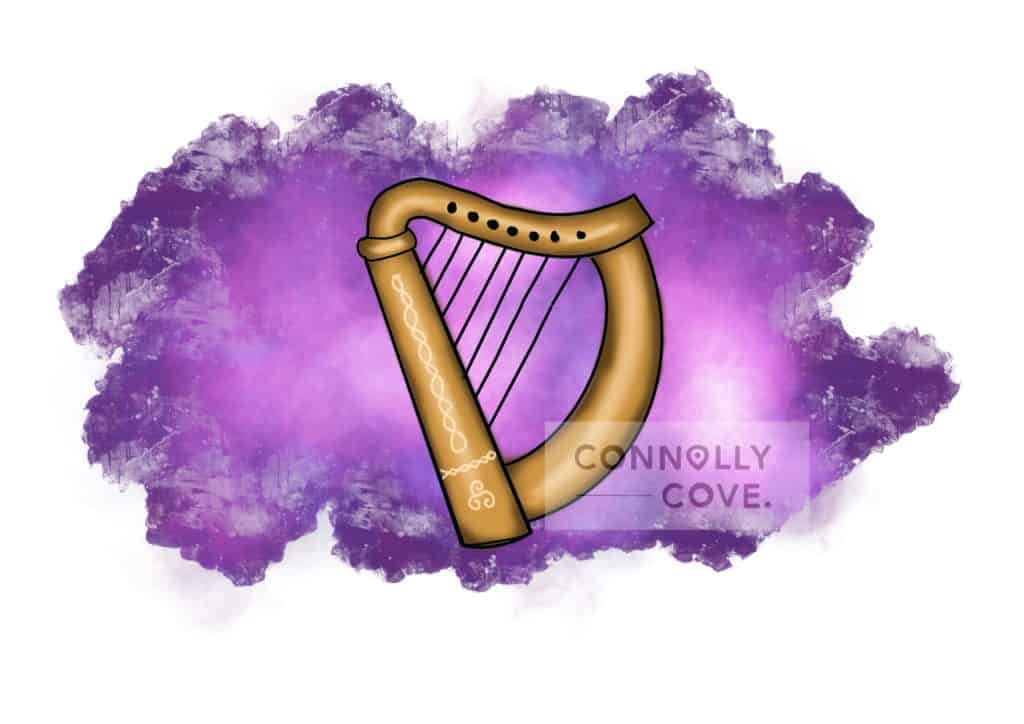
Fiddle: The Irish fiddle is an essential Irish traditional instrument that resembles the violin. However, it offers a unique playing style and sound that sets it apart. The fiddle is usually heard in traditional Irish music above all other instruments.
Tin-whistle: The Tin-whistle, or “feadóg” as it is known in Irish, is a small wind instrument with a high-pitched sound. The user blows into the whistle at the top and can play notes by covering different combinations of the 6 holes on the whistle. There is also an enormous low whistle that plays a lower-pitched tone.
The Accordion, Irish flute, Concertina and Uileann bagpipes are traditional Irish instruments commonly played in Irish Trad. These instruments are utilised by Irish musicians in combination with more familiar instruments, such as guitars and pianos, to create songs that feel both modern and distinctively Irish.
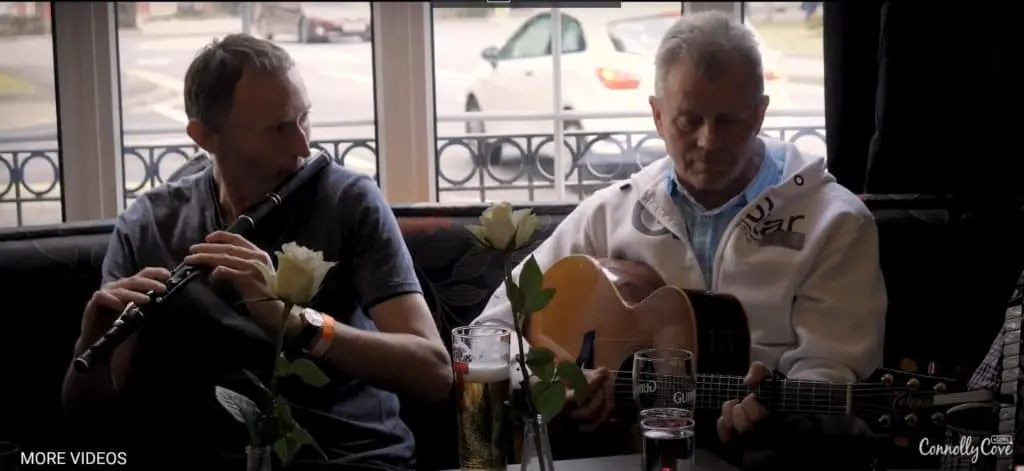
Traditional Irish Dancing
One of the most famous Irish traditions is Irish Dancing. It’s a phenomenon not just in Ireland but worldwide, especially in places with a large population of Irish descendants like Chicago and Boston, USA. Irish dancing is a variety of traditional dances that compromise solo and group routines.
Irish Dancing is a huge part of Irish culture & heritage, and over the last few decades, the tradition has grown in popularity with younger generations. This newfound revival can be attributed to the success of Riverdance.
Riverdance was first performed at the 1994 Eurovision Song Contest, transmitted to over 300 million viewers worldwide. Anúna performed the vocals with “The Lord of the Dance”, Michael Flatley and Jean Butler, leading the revolution of Irish dance.
Did you know? Ireland is the only country in history to host Eurovision three consecutive times: from 1993 to 1995. Ireland has also won the competition the most times, with 7 wins overall. This success is a testament to the country’s love for music and dance!
Riverdance became an instant classic worldwide and created a whole new version of traditional Irish dancing, emphasising emotion and storytelling. Words could never do the performance justice, so check out the original performance below.
The History of Traditional Irish Dancing
Although it may have created a resurgence of the tradition, Irish dancing was around long before Riverdance was ever a thing. For centuries, many people in Ireland took up Irish dancing as a fun activity as children and continued to enjoy it as adults. Traditional Irish dancing has been a massive feature in Irish-themed events and celebrations such as St. Patrick’s Day.
Irish dancing is unique because it is entirely different from modern dancing. It has its distinctive form and rules that have captivated people for decades. Even today, people of all ages still practise the various steps involved in Irish dance routines, including jigs, reels, ceilis and step dancing.
In previous generations, dance halls were one of the most popular places for people to socialise. Many elderly people recall meeting their future husband or wife at a dance hall, so you needed to know a few steps!
Traditional Irish Clothing
Irish traditional Clothing has always focused on durability and functionality rather than aesthetics and appearance. However, that is not to say that they are not beautiful. It is just that historically, the priority was for the garments to be well-made and last for a long time.
Galway Shawl
First up on our list of traditional Irish clothing is the Galway Shawl. Traditionally worn by women during the Winter, the shawl was warm and functional. When the Galway Shawl was first introduced, it was considered ‘Sunday best’. It was so formal and revered that brides-to-be often received it upon marriage.
Many older women continued to wear the shawl well into the 20th century. However, it is rare to see someone wearing a Galway Shawl today.
Aran Sweater
The Aran Islands are located along the Wild Atlantic Way in Co. Galway and are home to the iconic Aran Sweater. The world-famous sweaters are made from sheep’s wool. They are comfy and waterproof – essential for Irish weather! Initially worn by farmers and fishermen on the Aran Islands to keep dry while braving the elements, the sweaters are functional yet fashionable.
Even today, Aran Sweaters are a timeless classic and a staple of many wardrobes.
Claddagh Ring
The Claddagh Ring is known for its distinctive design, with two hands clasping a heart adorned with a crown. The heart symbolises love, the hands symbolise friendship, and the crown symbolises loyalty. The Ring has been used for engagements in Ireland for centuries because of what it symbolises.
The ring is worn by both men and women across Ireland and beyond. The hand on which the ring is worn and the direction it faces can tell you if a person is single, in a relationship, engaged or married.
The ring originated in the seaside town of Claddagh in Galway. Richard Joyce is credited with designing the Claddagh ring after being captured and sold as a slave to a goldsmith. When freed, he returned home to Ireland with the first-ever Claddagh ring, which he aptly gave to his future wife.
We have an entire article about the Claddagh ring for you to check out and another about exceptional Celtic jewellery throughout Irish art history.
Flat Cap / Paddy Cap
Originating throughout Ireland and the United Kingdom, the flat cap falls under many different names, including a ‘Bunnet’ in Scotland, a ‘Dai Cap’ in Wales, and a ‘Paddy Cap’ in Ireland.
These caps have been worn for centuries and have recently resurfaced as a fashion piece, thanks to the massive success of ‘Peaky Blinders’, a BBC crime drama set in the early 20th century. Flat caps are an iconic piece of the Shelby Clan’s wardrobe in the show.
Irish actor Cillian Murphy starred in the drama as the brilliant Tommy Shelby. As the show became a massive international success, everything from his haircut to his Paddy Cap became fashionable. You will most commonly see Irish men wear the cap at special occasions or horse racing events. Irish people don’t typically consider it an everyday hat, although some farmers still wear it.
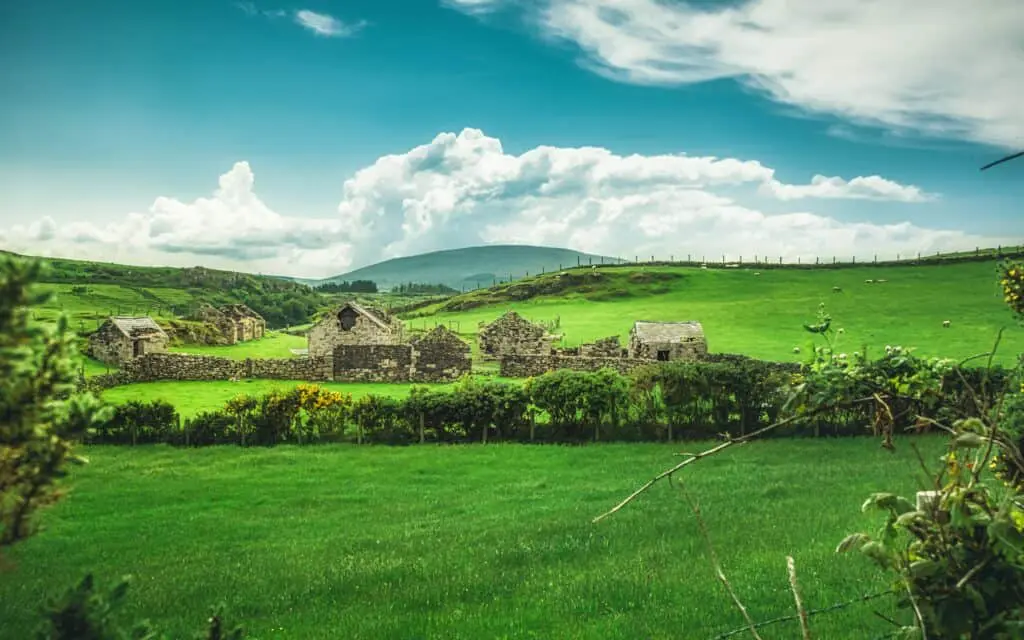
Traditional Irish Food
One of our favourites among the many famous Irish traditions is all of the amazing and unique food that comes from Ireland. If you plan on visiting Ireland anytime soon, make sure to try some traditional Irish meals. Many dishes in Ireland were made with scarce ingredients. They are not fancy, but these traditional dishes remind us of home and are hearty-filling meals.
Irish Stew
Irish Stew is one of our most beloved classic Irish food dishes and is considered the national dish of Ireland. It’s also trendy to have Irish Stew on St. Patrick’s Day. The most common ingredients in Irish Stews are lamb, mutton, potatoes, carrots, turnips and onions.
When the Irish started emigrating to America, they brought their food traditions. The recipes of these dishes began to adapt and evolve to include local ingredients and flavours. Cities across the USA now have unique local variations of the traditional Irish dish.
Irish Stew has been around for centuries and is most prevalent in winter. It is a warm, comforting dish that can be altered to suit different tastes and palettes. You’ll find that many places around Ireland keep to the traditional recipe. It is a must-try next time you’re at a pub or restaurant.
Traditional Irish Soda Bread
Another much-loved traditional Irish food is Soda Bread. Soda Bread is a simple classic in Irish cuisine. Across Ireland, nearly every family has a unique recipe for this traditional bread.
The history of making Soda Bread began for practical purposes. The first people to use soda were the Native Americans. However, the Irish earned a worldwide reputation for their bread.
Irish Soda Bread was first created in the late 1830s when baking soda was first introduced in the UK. Ireland was going through financial strife and had little access to ingredients. Because soda bread did not require expensive ingredients, it quickly became necessary across Ireland.
The ingredients needed to make Irish Soda Bread include wheat flour, baking soda, buttermilk and salt. To make soda bread softer, wheat flour was preferred, and the Irish climate was considered one of the only places suitable for growing this type of wheat.
From the late 1830s onwards, Soda Bread became a perfect Irish recipe that families could make at home. It was a simple and filling dish that they could afford. Many lower-class homes would cook the bread in Iron pots or on griddles over open hearths. This is how the bread got its signature texture and flavour: the hard crust and slight sourness that it’s now famous for.
Soda Bread is one of those Irish traditions that will never go away. It is enjoyed across generations and is part of the lives of nearly every Irish family. Eating the bread makes many people nostalgic as it was a staple of Irish life growing up.
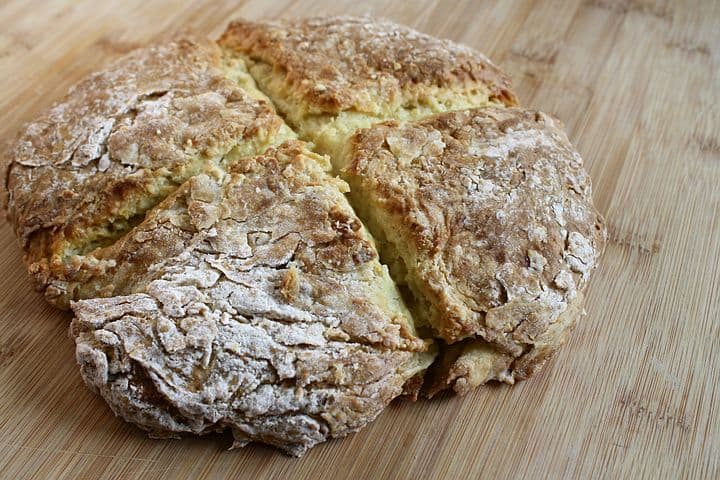
A Full Irish Breakfast
There’s no denying that the Irish love their food. Around the world, many people usually enjoy ready breakfast meals, but there has long been an Irish tradition of having a fried breakfast (simply called a ‘Fry’). It’s a meal that will fill you up and give you energy for the day ahead.
A traditional Irish breakfast includes a variety of meats and other proteins. Some ingredients commonly found in a full Irish breakfast include bacon (rashers), sausages, pudding, eggs, baked beans, hash browns, mushrooms and fried tomatoes.
You may even fry a few spuds (potatoes) if you feel adventurous! The hearty breakfast is also served with homemade Irish Soda Bread or potato bread (also known as boxty) and a strong cup of tea, coffee, or a glass of fresh orange juice.
The history of Irish frys is rooted in the country’s culture throughout history. It was initially a tradition to eat a full Irish breakfast to prepare people for a full day of work on the farm. This was essential because many people would spend hours performing physical work before returning for lunch or dinner.
In today’s modern world, having a full Irish breakfast on most working mornings is impossible because many people have to commute for work, especially those living in rural areas. Additionally, people are more health conscious today and try to avoid eating large quantities of fried food regularly.
However, the tradition of a full Irish breakfast serves as a staple treat in many households in Ireland. It is usually prepared on a Saturday or Sunday morning when families have time to make and enjoy breakfast. It’s also a meal that you can have for your evening dinner, and many Irish people enjoy doing this.
The Breakfast Roll
A traditional Irish breakfast roll is a full Irish breakfast rolled into a baguette with butter and ketchup. The breakfast roll is an iconic staple in modern Ireland. As our careers have diversified and Ireland is no longer predominantly a farming country, people who work outside the home opt for breakfast rolls because they are quicker to make than a fried breakfast.
The breakfast roll is a very popular menu item in Irish shops and delis. It typically consists of sausages, rashers, pudding, eggs, hash browns and tomatoes or mushrooms. The chicken fillet roll is also popular, containing a breaded chicken fillet, lettuce, and cheese in a baguette.
It’s impossible to deny that the Irish can’t adapt to the important things!
Shepherd’s Pie
Shepherd’s Pie is a staple at any Irish family’s dinner table. The filling is rich with lamb, vegetables and gravy and topped with mashed potatoes. The dish is considered a comfort food that Irish people love, especially during the cold, dark winter.
Shepherd Pie was first introduced by housewives in the late 1700s and early 1800s. They were looking for ways to incorporate leftovers into their meals. Even though Shepherd’s Pie was created out of leftovers, it quickly became a delicious and much-loved Irish dish.
As time has gone on, Irish people have loved to put their spin on the traditional Shepherd’s Pie by adding different seasonings and vegetables. Everyone makes their version of mashed potatoes, too, so eating a Shepherd’s Pie can be a very diverse experience, depending on where you are having it.
For many Irish people, even the best chefs in the world could not improve the recipe they grew up with! You will find Shepherd’s Pie in most Irish pubs and restaurants, and you’ll be sure to notice different flavours depending on what part of Ireland you’re in.
Traditional Irish Potato Bread
Traditional Irish potato bread, often called “boxty” or “potato farls,” has a rich history deeply rooted in Ireland’s agricultural heritage. Its origins can be traced back to the 18th century when the potato was introduced to Ireland by Sir Walter Raleigh.
Potatoes quickly became a staple crop for the Irish due to their hardiness and nutritional value. As a result, inventive Irish bakers began incorporating this newfound ingredient into their bread recipes.
The earliest variations of potato bread were simple, combining mashed potatoes with flour and water. Over time, the recipe evolved, and regional differences emerged. In Northern Ireland, for instance, it became known as “potato farls,” while in other regions, it retained the name “boxty.”
This evolution reflected the resourcefulness of the Irish people in making the most of their available ingredients during times of economic hardship, such as the Great Famine in the mid-19th century.
Traditional Irish potato bread is characterized by its minimalistic yet flavorful ingredients. The primary components include mashed potatoes, wheat flour, baking powder, and salt.
To make it, peeled potatoes are boiled until tender, mashed, and combined with flour, a pinch of salt, and a leavening agent, typically baking powder. The dough is then kneaded, rolled out into a circular shape, and cut into quarters or “farls” before being cooked on a hot grill or skillet.
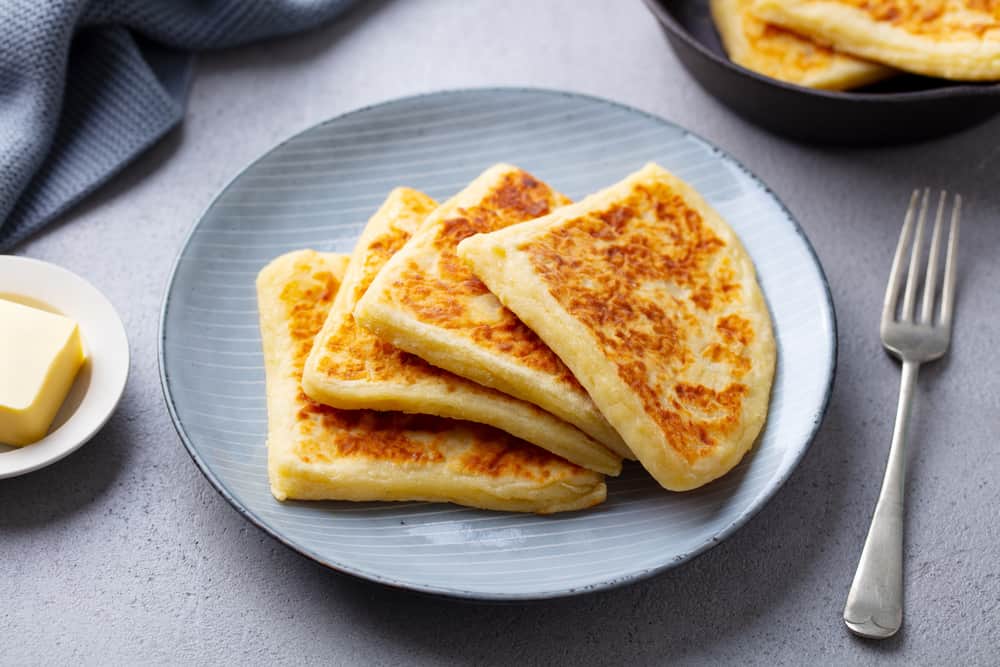
The griddle or skillet imparts a crispy, golden-brown exterior while the interior remains soft and fluffy. The result is a hearty, slightly sweet bread with an earthy potato flavour that pairs wonderfully with various toppings, such as butter and jam, or savoury toppings like bacon and eggs.
Potato bread has become a beloved part of Irish cuisine, often served in homes and restaurants nationwide. Its role in the traditional Irish breakfast, alongside other staples like black and white pudding, sausages, and eggs, is iconic. It also features prominently in conventional Irish celebrations like St. Patrick’s Day.
Bacon and Cabbage
A firm favourite in many households, Bacon and Cabbage is a simple and hearty traditional Irish dish. To make it, cabbage and bacon are boiled together in a pot. Boiled potatoes, turnips, carrots, and a parsley sauce accompany the dish.
The original purpose of traditional Bacon and Cabbage was to be a nutritious meal for farmers working long days in the field. It needed to be warm and filling, giving them energy after a long day of physical labour. Once again, many Irish people experience great nostalgia for eating the dish as a child.
Popular variations of this traditional Irish meal include Bacon and Turnip and Corned Beef and Cabbage. Although, the latter is more popular in the USA than in Ireland.
Baírín Breac or Barmbrack
Baírín Breac or Barmbrack is a cake of bread mixed with fruits and spices. “Brack”, as it’s commonly known, is often enjoyed with a cup of tea. It is eaten all year round but has a unique tradition when served on Halloween.
Traditionally, a ring is placed in the Brack when baked at Halloween. Whoever receives the slice with the ring in it is said to be the next to get married. Sometimes, a coin is also placed inside, and the lucky recipient is said to become rich within the next year!
This tradition is still widespread across Ireland today. At nearly every house you visit during Halloween, you’ll find a loaf of Barmbrack.
Seafood:
Fresh seafood is never too far away from cod, salmon, and oysters. With so many coastal towns along the Wild Atlantic Way, there is an abundance of fish takeaways and seafood restaurants offering the classics, such as fish and chips and seafood chowder.
Ireland’s rich maritime heritage and extensive coastline, which stretches for nearly 3,200 kilometres, have endowed the nation with diverse fish and seafood. The cold, nutrient-rich waters of the North Atlantic Ocean provide a habitat for numerous species, making Irish waters a prime fishing ground.
Among the most common types of fish caught off the shores of Ireland are Atlantic salmon, trout, mackerel, haddock, cod, and hake. Additionally, shellfish like mussels, oysters, and Dublin Bay prawns are abundant in Irish waters, adding depth and variety to Ireland’s traditional seafood cuisine.
Traditional Irish cuisine boasts a variety of seafood dishes that have been enjoyed for generations. One of the most iconic parts of the Irish diet is fish and chips, a staple featuring battered and deep-fried fish, typically cod or haddock, served with thick-cut potato chips and often accompanied by mushy peas.
Another traditional Irish classic is smoked salmon. The Irish take great pride in their expert smoking techniques that create a delicate and flavourful product. Seafood chowder is another cherished dish, a hearty soup brimming with a medley of seafood, potatoes, onions, fresh herbs, and cream.
Traditional Irish seafood cuisine also embraces more modern twists, such as seafood pie, where a creamy seafood mixture is topped with mashed potatoes and baked to golden perfection. Similarly, newly popular seafood pasta showcases the versatility of new Irish cuisine.
Seafood has played a vital role in Irish history and culture, reflecting the close connection between the Irish people and their natural surroundings. Historically, coastal communities relied heavily on bountiful catches from Irish waters to survive, and this dependence on the sea forged a deep cultural appreciation for seafood.
In Irish tradition and folklore, the sea and its bounty are celebrated in stories, songs, and festivals. For example, Saint Patrick, the patron saint of Ireland, is said to have blessed the sea, ensuring an abundant fish harvest for the people.
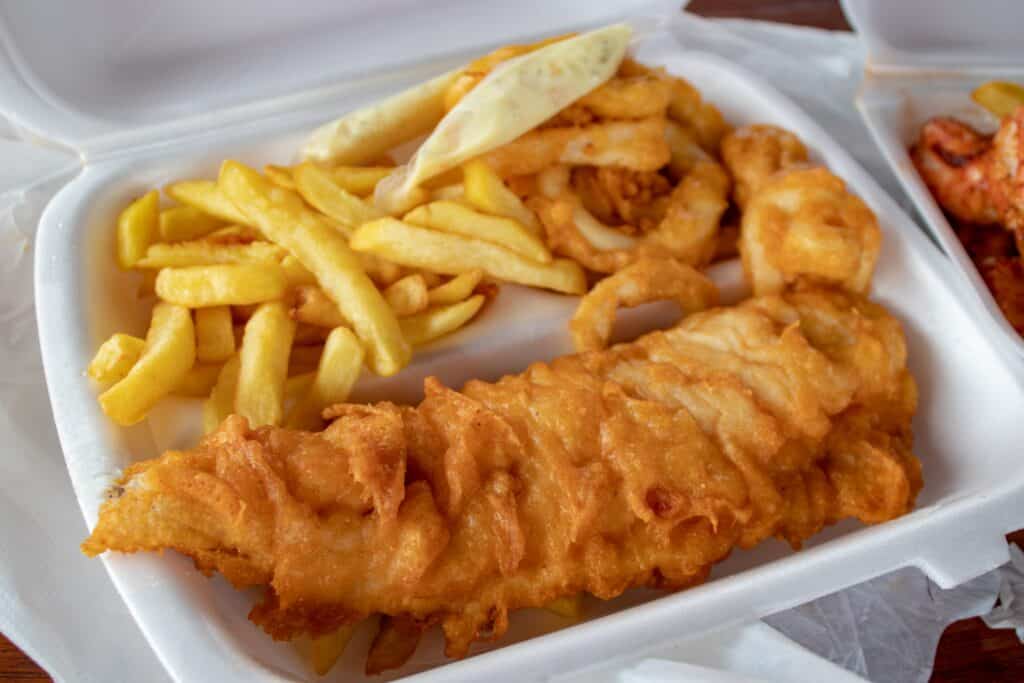
Traditional Irish Sports
Sports are a popular pastime in Ireland and around the world. Although the Irish play international sports such as soccer, rugby, and basketball, we have sports unique to Ireland. These Irish sporting traditions have been around for centuries and are still an essential part of life and culture in Ireland today.
The sports that are unique to the Irish are categorised as Gaelic games. Gaelic games, or GAA games, comprise Gaelic and Ladies Football, Hurling, Camogie, Rounders, and Handball. Each of these sports is incredibly popular in Ireland. Statistically, it is thought that every time the Irish attend a sporting event, one out of two will attend a GAA game.
This statistic is pretty impressive, considering most Gaelic sports only have amateur status, but GAA sports have teams in every small village. Children are raised playing them from ages 5 and up, and most continue playing into their late 20s. There are also over 40’s and over 50’s teams to encourage people to stay fit and active.
The amateur status of GAA games is a testament to the passion of both players and fans alike. These sports play a huge part in Irish culture. GAA clubs are an integral part of many small Irish communities, even outside of Ireland, due to the grassroots teams in Irish villages and international clubs around the world.
GAA fans are insanely passionate about their teams. Croke Park’s national stadium attracts over 60,000 people to hurling or Gaelic game finals. This shows how proud the Irish are of their sports and watching their fellow Irish men and women play. The games organised by the GAA (Gaelic Athletic Association) – are one of the most vital communities in Ireland.
Gaelic football & Ladies Football
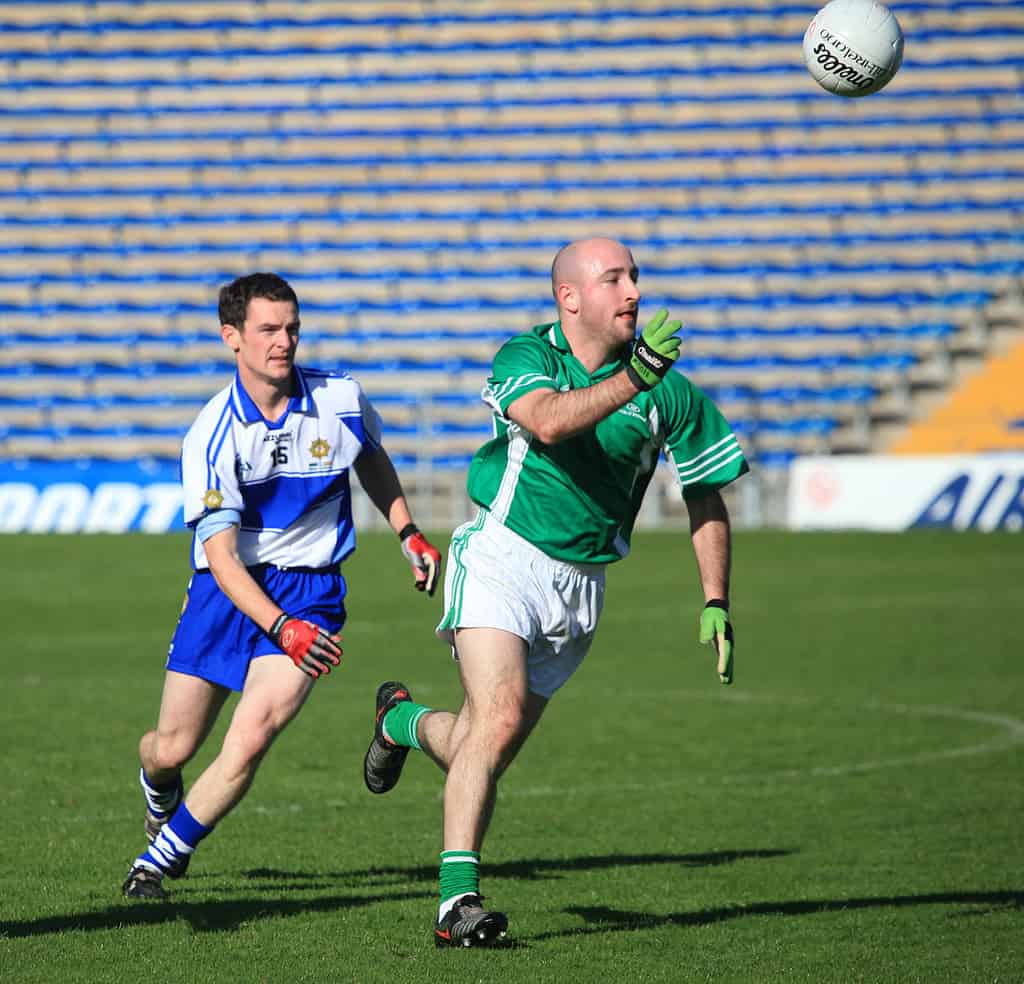
Gaelic football in Ireland is often just referred to as ‘Gaelic’ and is a popular sport in Ireland. It consists of two teams of 15 men playing against each other on a grass pitch. The unique thing about this traditional Irish sport is that you can use your hands and feet to move the ball. It is one of the most popular recreational activities in Ireland today.
Gaelic football is an Irish field invasion game. Field invasion sports are games where each team tries to invade their opponent’s territory and score a goal. They are fast-paced games, with multiple strategies such as defending, keeping possession of the ball, moving towards a goal-scoring position, and teamwork being utilised at all times.
Gaelic football has many distinguishing features that allow it to stand out from other field invasion games such as football (soccer, to Americans), American football, basketball, ice hockey, and so on. The round ball can be kicked, caught in your hands, hand-passed and punched. The only thing the players can’t do is run more than four steps with the ball in their hands.
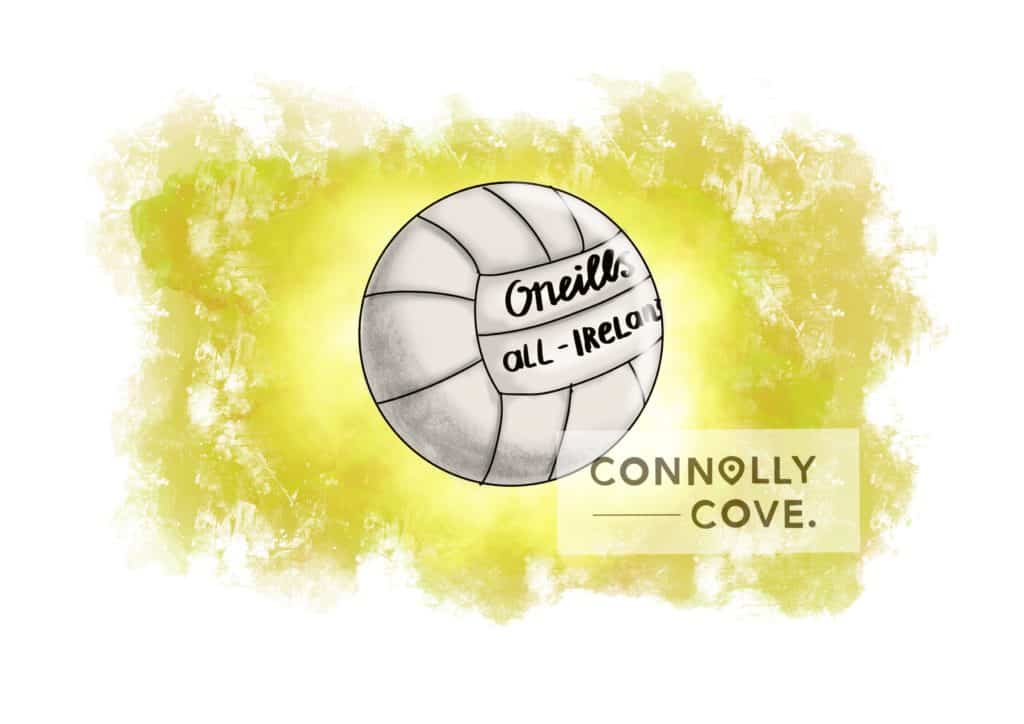
After a player takes four steps while carrying the ball, the ball must be bounced or soloed. A solo is performed by dropping the ball onto one’s foot and kicking it back into one’s own hands. Players cannot bounce twice in a row, and shoulder-to-shoulder contact is permitted, allowing opponents to force possession away.
There are multiple ways to earn points for your team in a Gaelic football match. One point is scored in when the ball is kicked or punched over the crossbar and between the goalposts. Alternatively, a goal is worth 3 points when a player kicks the ball into the net.
Ladies football is very similar to Gaelic football. Both are played on the same field with the same equipment, under the same general basic rules. One notable change in Ladies’ football is that players can pick up the ball directly off the ground. This is considered a foul in Gaelic football; male players must chip the ball off the ground using their feet before catching it in their hands.
Watch the video below to see the sport in action, or check out the official GAA website for more information on getting involved!
Hurling & Camogie
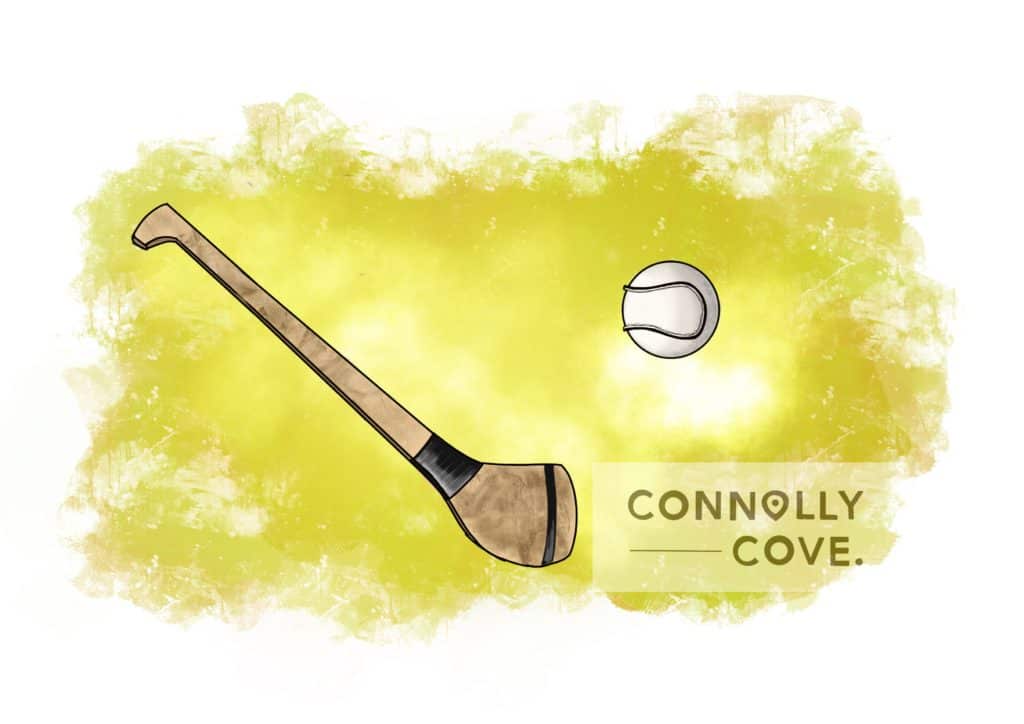
Another popular GAA game is Hurling, widely considered a skilful traditional Irish sport. The game of Hurling goes back thousands of years and has often featured heavily in Irish literature and legends, such as the story of Setanta.
How you play the sport, including the number of players, scoring, and the rules, are very similar to Gaelic football. The most significant difference is that it’s played with sticks known as a Hurley, or Camán in Irish, and a small leather ball, or sliotar.
In Hurling, each team consists of 15 players. It is a field invasion game in which teams try to score in the opponent’s “H” shaped goalpost. A “point” is worth one single score for the team and occurs when a sliotar is hit over the post. A goal worth 3 scores occurs when the sliotar is hit under the bar and into the netted goal.
Camogie is the title for the female version of Hurling. They are almost identical, playing on the same field and under the same standard basic rules. One difference is that Camogie players may only handpass the sliotar over the bar to score a point. They are not permitted to handpass the ball into the goal.
Like Gaelic, the aim is to score more than the opposing team. Contrastingly to Gaelic football, however, many Hurling players wear helmets as the sport can sometimes be very physical. Check out the hurling videos below to understand this traditional Irish sport better.
Handball & Rounders
GAA Handball is a fast-paced, highly skilful singles or doubles game of hitting a ball against a wall. There are four codes of handball in Ireland: 40×20, One-Wall, 60×30 and Hardball. These codes each have unique requirements, such as the size of the court, the number of walls in the court and the type of ball used.
GAA Rounders is a bat and ball game that can be compared to American baseball. It is actually believed that baseball is potentially derived from rounders. The sport has been played on the Emerald Isle for hundreds of years and was probably brought to America by early Irish settlers and immigrants.
Other popular traditional Irish sports include horse racing, fishing and golf. Some international sports, such as Rugby and football, are also prevalent across Ireland. Football in Ireland is played semi-professional, whereas rugby is a professional sport at national and international levels. Ireland’s rugby team has seen great success in recent years.
The History of GAA
The GAA is celebrated as one of the world’s most significant amateur sporting associations and plays a huge part in Irish tradition, culture, and society. The club was founded in 1884 in County Tipperary by a group of Irishmen who saw the importance of creating a national organisation to revive and nurture traditional sports. It was also a fundamental way for Irish athletics to become more well-known.
Six months after the first GAA meeting, GAA clubs started forming around Ireland. This period saw the beginning of people playing Hurling and Gaelic Football for the first time in years. With newfound pride, Irish people started participating in GAA events nationwide.
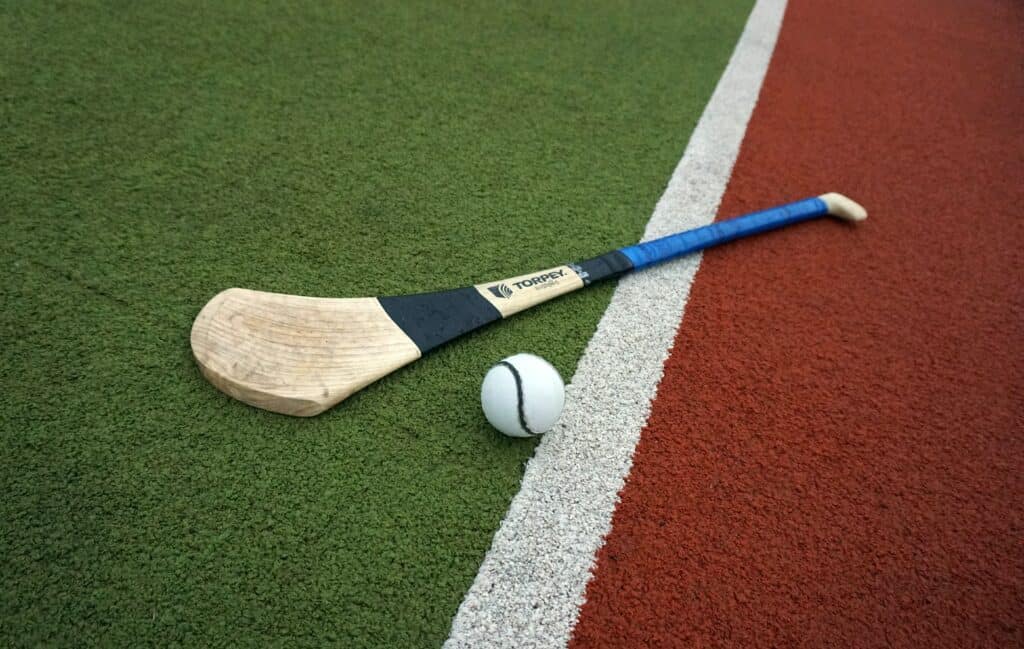
Since its beginning, all the sports under the GAA have remained amateur sports. Even players at the highest level of GAA don’t get paid for playing despite a demanding and intense training schedule. Still, they are dedicated to their sport.
This highlights one of the most critical aspects of GAA: its volunteer ethos. Players aspire to reach the inter-county level for the pride of representing their family and community parish, even though no fortune can be gained.
Of course, in recent years, players have seen some financial incentives enter the GAA world. Brand sponsorships and travel and general expenses coverage have made the commitment more viable.
The GAA organisation is usually based around Ireland’s traditional parish and county structures.
It strongly emphasises community, and there are over 2,000 clubs around the 32 counties of Ireland. Every summer in Ireland, inter-county All-Ireland Championships in hurling, Gaelic and Camogie draw out the Irish public.
With the Irish Diaspora, the GAA sports continued to develop worldwide, as emigrants took their familiar Irish sports to their new homes in the USA, Australia, and Europe, among many other places. There are believed to be over 400 GAA clubs worldwide, which is impressive for an amateur sport.
Traditional Irish Language
Although English is the primary language spoken in Ireland, the Emerald Isle also has its unique language known as Gaeilge. The Irish language, along with its sister languages, Welsh and Breton, are some of the oldest living languages in Europe.
The Gaeilge Language is recognised as the national and first official language of the Republic of Ireland and a minority language in Northern Ireland. The Irish language is also one of the official languages of the European Union. In reality, however, the majority of people in Ireland speak English.
It is taught in schools across the country to preserve the Irish language. Irish is taught in many schools throughout the Republic of Ireland and Northern Ireland, but it faces criticism as students spend over 10 years learning the language but are rarely fluent.
Irish primary school teachers (who teach students aged 4-13) must spend time at the Gaeltacht to ensure their proficiency in the language. It shows how the Irish strive for future generations to have a genuine understanding and appreciation of the language of Ireland, even if we primarily speak English.
If you visit anywhere in Ireland, you’re sure to notice the language on the road and street signs in the Republic and some regions of Northern Ireland.
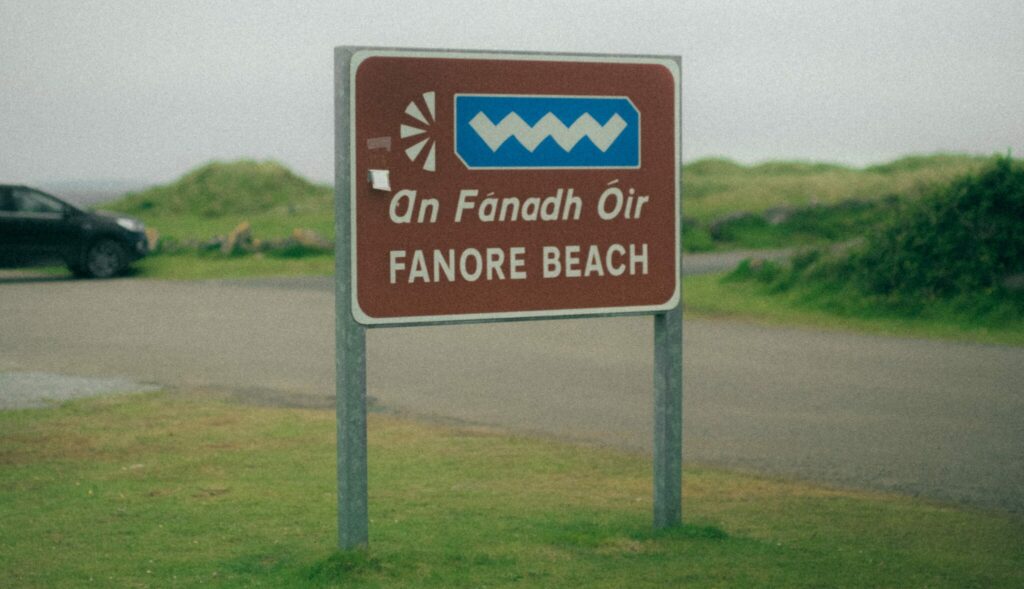
The Gaeltacht
Although English is the language most used throughout Ireland, some parts of the country are where Gaeilge, or Irish, is the primary language. The majority of communities where Irish is spoken predominantly are found in Galway, Kerry, Cork and Donegal. These areas are called the Gaeltacht regions.
Popular Gaeltacht regions include Conamara in Co. Galway, Corca Dhuibne in Co. Kerry, Acaill Co. Mayo, and the many Gaeltacht towns in Co. Donegal, such as Gleann Domhain and Ard a Rátha. The Gaeltacht regions offer many traditional Irish experiences. These include GAA clubs, Irish dancing halls, Ceilis, and live traditional Irish music in Pubs.
The Gaelatchts are also recognised for their natural beauty and the Irish heritage sites found along the Wild Atlantic Way, the Western coast of Ireland, which the Atlantic Ocean has shaped. These vistas are stunning to explore and are popular tourist attractions.
Whether or not children in Ireland learn the Irish language can come from their family’s traditions, as it’s often passed down from generations. Some Irish people may speak Irish inside their homes and English in their wider community.
How to Say Common Irish Phrases
Most people in Ireland will know how to speak a few Irish phrases and sayings, but over time there has been a massive decline in people learning and speaking the language. However, the Irish language will always be essential to Irish traditions and culture.
Check out some of the most popular Irish phrases and sayings below:
- Is fearr Gaeilge briste, ná Béarla clíste – ‘Broken Irish is Better than clever English.’
- Sláinte – ‘Cheers’ (pronounced “slawn-che”) (literally means “health”)
- Dia Duit – ‘Hello’ (pronounced “jee-a-gwitch”) (literal meaning is “god be with you)
- Fáilte -‘Welcome’ (pronounced “fawl-chuh”)
- Is Mise…. – ‘My Name is’ (pronounced “mis-shah”)
- Conas atá tú – ‘How are you’(pronounced “cun-iss a-taw tu”)
Irish Traditions Surrounding Pub Culture
Another famous aspect of Irish tradition relates to pub culture, a huge aspect of life in Irish society across all cultural divides. It refers to the Irish habit of spending time in pubs and bars frequently.
Traditionally, in Ireland, pub culture is about more than just drinking. Irish people love to head to the pub for social gatherings. It’s an important meeting place where friends and family can congregate in a relaxing atmosphere.
Each place you visit in Ireland will have its pub that is popular among the locals. Tourists visiting Ireland should make a point to visit a traditional pub that features traditional music and a welcoming atmosphere.
Traditional Irish Myths and Legends
Traditions of storytelling in Ireland have been around since the beginning of time, providing some of the richest mythology and legends in all of Western Europe. Some of the characters of these Irish myths and legends have become famous figures around the world.
The Irish custom and tradition of storytelling have preserved our ancient love of legends and mythology, allowing us to share the stories that shaped our mythos with each new generation. Old Irish traditions were passed down from generation to generation by seanchaí, or storytellers, by word of mouth before we ever had the means to record them.
Here are some of the most famous Irish Myths and Legends:
The Children of Lir
The Children of Lir is a very old Irish myth that goes back to the ancient tribes of Ireland. It has also been considered as the inspiration behind the world-famous ballet Swan Lake. Check out our blog, the Children on Lir, to find out more about the fascinating story of love, jealousy, and betrayal.
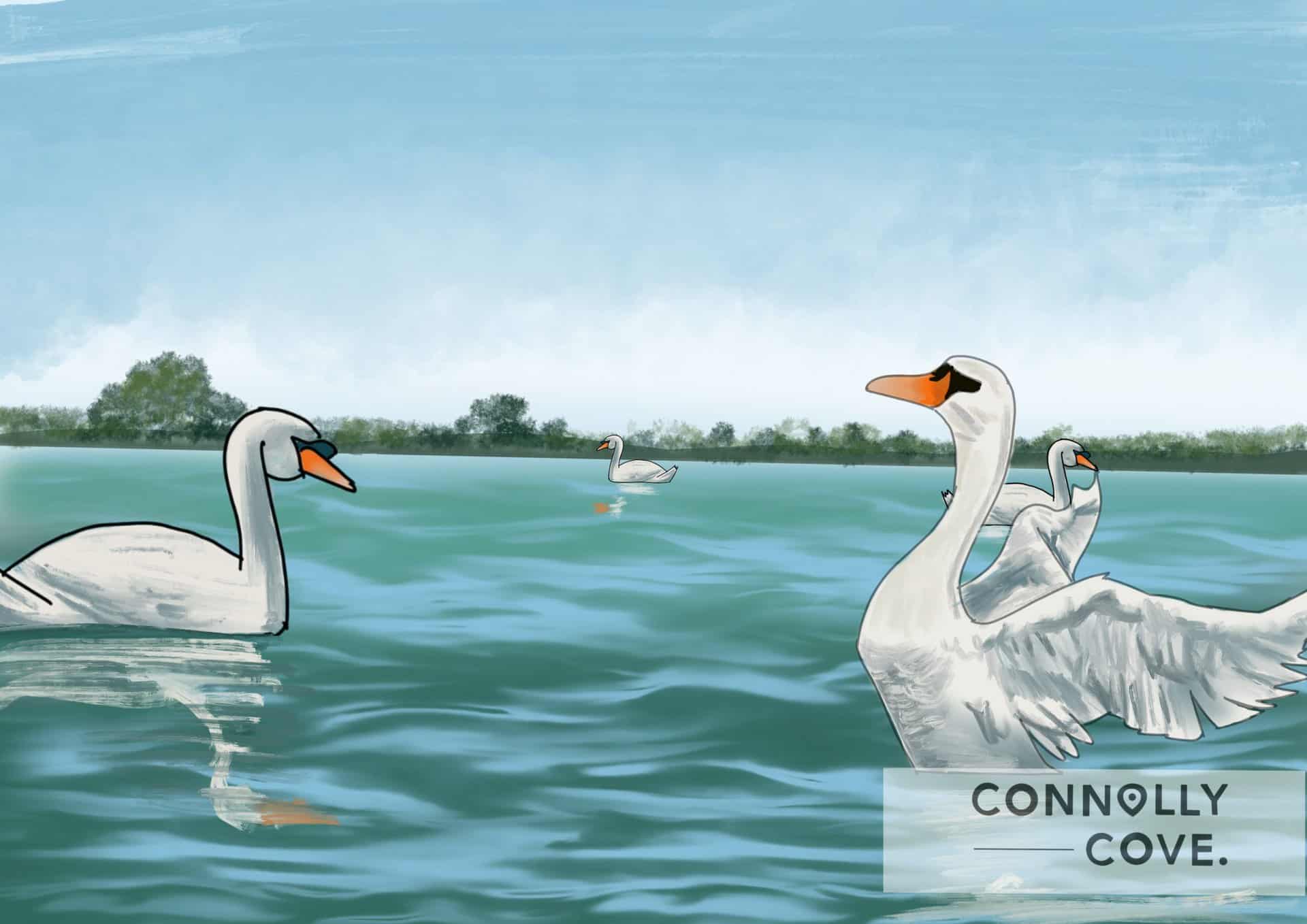
Finn MacCool and the Giant’s Causeway
One of the most famous Irish legends is the mythological giant known as Finn MacCool. He appears in many Irish stories. Finn MacCool has long been connected to the Giant’s Causeway along the north coast of Ireland.
Irish legend states that a Scottish giant called Benandonner ripped up the causeway so he wouldn’t have to fight the fierce Finn MacCool. So, for many centuries, legend had it that this is the reason why the Giant’s Causeway exists. Of course, we know there is an actual geological explanation, but giants are a bit more exciting!
The video below explains how the causeway formed geographically.
Leprechauns
Another mythical creature commonly found in Irish legends is the Leprechaun; they have become iconic and synonymous with Ireland all around the world. The small mischievous spirit is the most widely known type of fairy believed to live in Ireland.
Irish legends suggest that they love to collect gold, which they would store in a pot and hide at the end of a rainbow. If you would like to read more about Ireland’s connection with fairies we have you covered. We will explore how to find fairy trees, fairy origins, the types of good and evil fairies and much more!
Irish Tradition and Symbols: The Shamrock
The iconic three leaves of the shamrock have undeniably become the unofficial symbol of Ireland. In Irish history, the shamrock has played an important role in our culture, traditions, and legends.
The Druids believed that the shamrock was a very sacred plant that could chase away evil. The Celtic culture also believed that three was a sacred number. Furthermore, Irish Christians believed the shamrock had a special meaning – its three leaves represented the Holy Trinity: The Father, Son and Holy Spirit.
A four-leaf clover is a type of shamrock that is considered to be very lucky. This is because they are said to be a rare mutation of the White leaf clover (the traditional shamrock we all know of) and are very hard to find. The chances are believed to be over 1 in 10,000! So, if you find a four-leaf clover, the luck of the Irish is on the way!
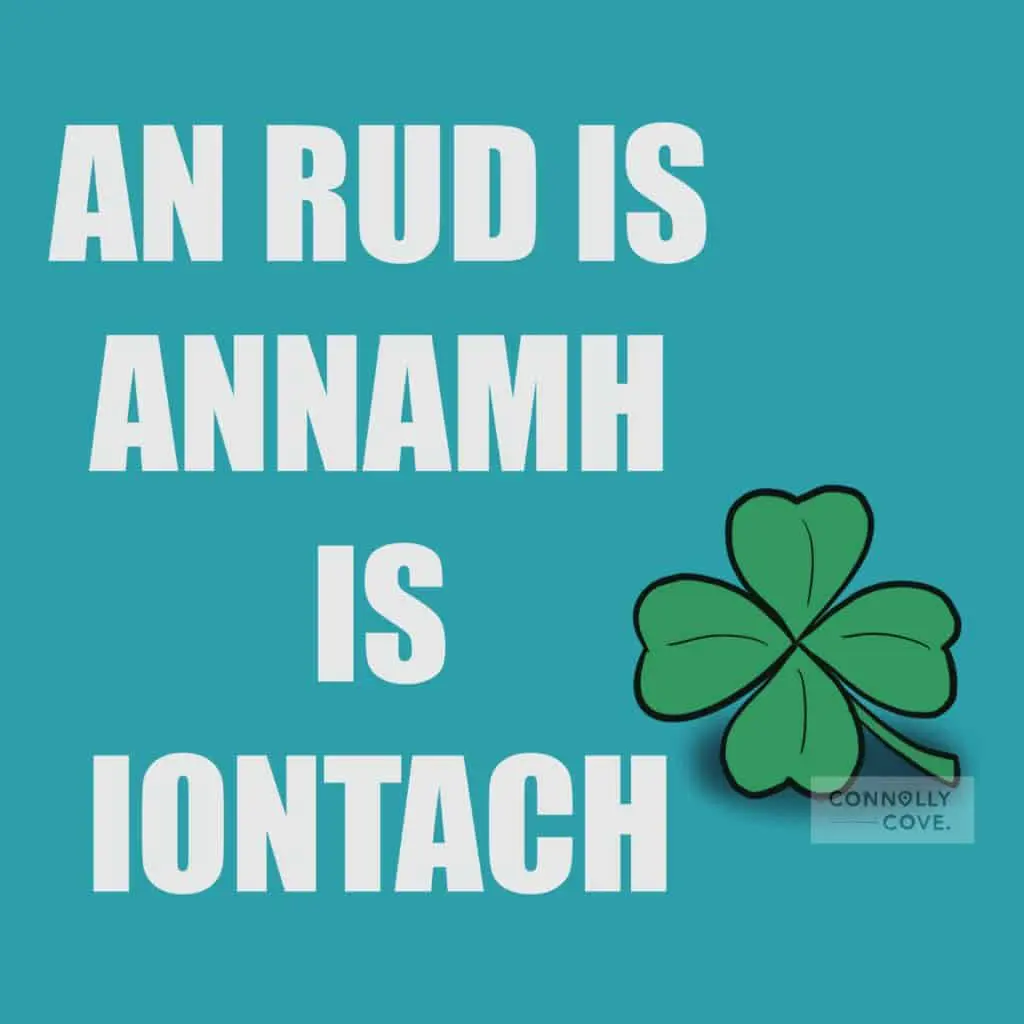
The above graphic is a Seanfhocail, or Irish proverb, which means “rare things are beautiful”. This perfectly describes the four-leaf clover!
The Shamrock is one of the most common symbols of the Irish worldwide, especially on March 17th (St. Patrick’s Day), as it is customary to pin fresh shamrocks on your clothes. Across the world, people wear shamrocks throughout the day, from morning mass to the parade and late-night celebrations.
Faeries
Throughout much of mythology all around the world, faeries have been heavily featured. However, they hold an extra important meaning to the Irish. There is a fairy society in Ireland that, even to this day, still exists, but it’s far from what you would have read about in fairy tales.
It’s believed that Irish fairies can take many forms but often choose to appear as a human. Faeries are said to be very powerful and beautiful. However, most fairies in Ireland are said to enjoy bringing misfortune and bad luck to those nearby.
Final Thoughts on Irish Traditions
There are many aspects of Irish culture, traditions, and customs that are unique to Northern Ireland and the Republic of Ireland and some that have left the shores of the Emerald Isle to be known all around the world. I hope you enjoyed our guide on some of the most famous Irish traditions and their origins.
Do you have any favourite Irish traditions? Please share them with us in the comments below! 🙂
Check out some of our other blogs that might interest you:
Irish Wedding Traditions| Irish Food Traditions| Insight into an Irish Wake and Superstitious Associated with it| The Curious Case of Irish Curses| The Superstitious Fairy Trees in Ireland|






